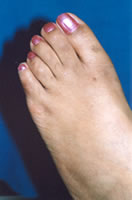A Tailor's Bunion (Bunionette) is a type of bunion that occurs on the outside of the foot at the base of the little toe. It is a prominence that may be caused by irritation of bone or soft tissue about the lateral aspect of the fifth metatarsal head. Symptoms result from shoe pressure over the bony prominence, local nerve irritation, capsulitis, or a bursa.
Tailor's Bunion is named from clothing tailors sitting with crossed legs.
There is a three to one female to male predominance. They are common in adolescents and adults. Two thirds of patients have significant pes planus (flat feet).
As far as anatomical pathology is concerned, constricting footwear over the lateral 5th metatarsal head yields pain and a bursa. There may be incomplete insertion or development of the transverse metatarsal ligament.
Hyperactive Abductor digiti minimi and Opponens digiti minimi muscles may be present. One may encounter insufficient insertion of the Adductor Hallucis muscle. One may posess a congenital wide 5th metatarsal head.
On clinical presentation, there is pain and irritation at the lateral 5th metatarsal head and prominence. An inflamed bursa may be present. Hyperkeratosis and erythema may be present over the 5th metatarsal head. The 5th toe assumes a varus attitude.
Radiological findings include rotation of the lateral plantar tubercle into a lateral position, increased intermetatarsal angle (IM)(normal 6.47degrees)-People with a tailor's bunion have an IM of 8.71 or greater, increased lateral deviation angle (normal 2.64) people with a tailor's bunion have a lateral deviation of 8.05 degrees, a large dumbbell-shaped 5th metatarsal head, arthritic changes resulting in exostosis (spur) formation at the 5th metatarsophalangeal joint, and any combination of the above conditions.
Type 1 Tailor's Bunion has enlargement of the lateral portion of the 5th metatarsal head. It approximately occurs in 27% of the cases.
Type 2 Tailor's Bunion results in lateral bowing of the diaphysis (shaft) of the 5th metatarsal. This occurs in approximately in 23% of the cases.
Type 3 Tailor's Bunion results in an increase in the 4th-5th intermetarsal angle. This occurs in 50% of the cases. Patients are most symptomatic with this type. Type 4 results from a combination of two or more of the above deformities and is frequently seen in rheumatoid arthritis patients.
Conservative treatments include wearing wide toe box shoes, debridement of lesions. Orthotics may be utilized to control pressure areas and mechanics of the foot. Non Steroidal Anti-Inflammatory Drugs may be taken. Injections may be given.
Surgical Treatment is indicated when conservative treatment fails. It is primarily indicated in special demands like sports. The goal is to decrease the width of the foot and decrease the pain and prominence of the Bunionette.
References
- Banks, Alan S. et al. McGlamry's Comprehensive Textbook of Foot and Ankle Surgery. Philadelphia: Lippincott Williams and Wilkins, 2001.
- Fallat LM, Buckholz J. Analysis of the tailor's bunions by radiographic and anatomical display. J AM Podiatry Assoc 1980;70:597-603.




